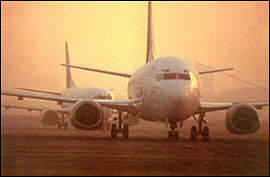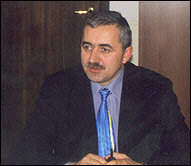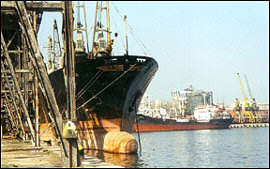 AVIATION AND MARITIME TRANSPORT AVIATION AND MARITIME TRANSPORT |

Another priority of the Ministry of Transport is the privatization of Tarom, the National Air carrier. In fact, the process has just recently started. The restructuring program of the company began in 1997, when the financial situation of the company was in pretty bad shape. At the time Tarom was losing US$ 82 million. In 2000 the company obtained its first profits in a long time. Several reasons account for this financial improvement: the total renovation of the fleet, considered to be among the most modern ones in the region, a better quality of services offered, and an increase of the number of flights and destinations. Today Tarom flies to 43 cities on 3 continents. In 1999 it exceeded 1 million passengers. Mr. Gheorghe Racaru, President & CEO of Tarom, foresees a further increase of 20% for 2000.

Mr. Aleodor
Francu,
Secretary of State for Aviation and Maritime Traffic
explains that after Tarom is evaluated, the company
will be sold to a strategic investor, hopefully
from one of the major European Airlines. "When we
are part of the European Union and the market will
be completely open, Tarom will have to be part of
a solid partner" stresses Mr. Francu. Indeed, there
are a number of potential buyers for Romania's national
carrier, although, according to Mr. Racaru, CEO
of Tarom, KLM-Alitalia is the one with more possibilities
to purchase it. |
Actually, the largest European aviation companies are seriously taking ground in Romania, having realized the untapped potential this country has. British Airways restarted flying to Bucharest in 1997 and now offers 10 flights per week. KLM has 2 flights per day and Alitalia, which had stopped flying for years, now flies daily. Air France has also very recently increased its frequency. Another explanation for the consolidation of most international carriers in Romania is the excellent geographic position of the country and the betterment of airport infrastructures. "Last year we just finalized the first phase of the new airport development and in October 2000 we will finalize the second phase: the new arrivals terminal" remarks the Secretary of State, Mr. Francu. With all these improvements, Mr. Francu is convinced that the Otopeni (Bucharest) airport could become an important hub in the region.

The same should apply to the Constanta Port, Romania's door to the Black Sea. In size Constanta is the second largest port in Europe, second only to Rotterdam. During Ceaucescu's time large sums of money were poured into the port. But today many of its facilities are obsolete. Mr. Francu is working on a master plan for the development of the port. The most ambitious project is a new cargo terminal, expected to be finished by 2003, being built together with the Japanese Government. The transformation of the harbor into a porto-franco, a LPG terminal (Liquid Propane Gas) and the construction of protection dams, are some of other highlights of the master plan. |

